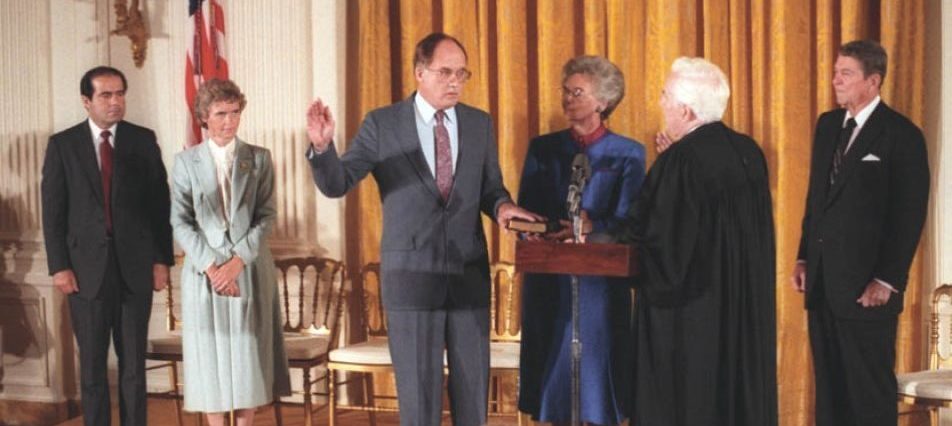Without Rehnquist's unique Glucksberg opinion, the conservative justices in Dobbs would have lacked a workable due process standard.
Rehnquist's Reservations and the Future of Roe
In 1973, the Supreme Court of the United States found, within the Constitution’s “guarantee of certain areas or zones of privacy,” a sweeping, near-absolute right to abortion. It has long been argued that the justices in Roe v. Wade concocted, rather than discovered, the announced right—that their ruling was an act of invention and imposition, not interpretation. As Harvard Law School’s Professor John Hart Ely observed at the time, Roe was “not constitutional law and [gave] almost no sense of an obligation to try to be.” It was, as Justice Byron White wrote in dissent, an “improvident,” “extravagant,” and “raw” exercise of judicial power.
At that time, William H. Rehnquist was the Court’s most junior member. He joined Justice White’s dissent, but also wrote a measured, respectful, and compelling separate opinion, demonstrating that the majority had acted more like a legislature than a court and had confiscated the prerogative of the people, through their elected and accountable representatives, to make policy concerning contested matters. As he observed, “[t]o reach its result, the Court necessarily has had to find within the scope of the Fourteenth Amendment a right that was apparently completely unknown to the drafters of the Amendment.”
Almost 20 years later, in Planned Parenthood v. Casey, a divided, bare majority of the Court reaffirmed what it characterized as Roe’s “central holding,” although that holding’s basis was relocated from “zones of privacy” to the Constitution’s “promise . . . that that there is a realm of personal liberty which the government may not enter.” “At the heart of liberty,” the majority declared, using language perhaps better suited to an overconfident college student’s essay than a federal judge’s opinion, “is the right to define one’s own concept of existence, of meaning, of the universe, and of the mystery of human life. Beliefs about these matters could not define the attributes of personhood were they formed under compulsion of the State.”
Again, and this time joined by three colleagues, then-Chief Justice Rehnquist dissented. Roe, he explained, “was wrongly decided, and . . . should be overruled[.]”
His dissenting opinions in Roe and Casey, along with his well-developed and clearly articulated understanding of the limited, restrained role of unelected judges in a constitutional democracy, provide a reliable starting point for Roe-skeptical justices as they confront next term the most important abortion-related case in nearly three decades, Dobbs v. Jackson Women’s Health Organization.
Squinting for the “Central Holding”
The Dobbs case involves a challenge to a 2018 Mississippi law, the Gestational Age Act, which prohibits abortions after the unborn child is 15 weeks old, except in medical emergencies or in instances of what the law calls “severe fetal abnormalities.” Most experts agree that, if Roe—or rather, Roe’s “central holding,” as reimagined by the justices in Casey—is the law, then the Act is unconstitutional. They agree also that at least six current members of the Court—and probably more, in their heart-of-hearts—believe that Roe was poorly reasoned.
If they would follow Rehnquist, the current Roe-skeptical justices will need to avoid at least two distracting detours—dead-ends, really. First, they should not imagine that by invalidating the Mississippi measure—perhaps while signaling regrets and conceding doubts about Roe’s original merits—they will (somehow) resolve the abortion debate and enhance the Court’s reputation for independence. In Casey, the crucial “swing” justices in the plurality intoned soberly, if presumptuously, about “call[ing] the contending sides of a national controversy to end their national division by accepting a common mandate rooted in the Constitution.” Never mind that there is little historical precedent for “controversy” and “division” ending as a result of unelected lawyers’ scoldings. These justices warned that the appearance of a “surrender to political pressure” would result in the “country’s loss of confidence in the Judiciary” but the evidence of the last three decades—including, for example, the degradation of judicial-confirmation hearings—suggests that, for many, the “surrender” that undermined “confidence in the Judiciary” was Casey’s reinvention-as-affirmation of Roe by justices who knew it was wrong but feared the headlines, editorials, and electoral consequences that would accompany its reversal.
It is, to be sure, entirely appropriate for federal judges’ work to reflect humility, modesty, and restraint. As a general matter, they should not be looking to make waves or to stand out as “change agents.” With respect to debatable questions, deference by those who are not politically accountable to those who are is a sound policy. To re-affirm Roe’s overreaching power-grab, though, would not be prudent self-restraint but rather petulant self-indulgence.
The second temptation to be resisted is to repeat Casey’s error: to squint and find an even-more-“central holding” of Roe, and to uphold the Mississippi Act, purporting to (somehow) have respected, while in fact re-inventing again, a past mistake. No one would be fooled. It is true that permitting, albeit in an unprincipled way, more regulations of abortion would better align American law with domestic public opinion and with most other constitutional democracies’ approaches. At the same time, it would (yet again) commit the Court to an undemocratic policy micro-management role, and to line-drawing and distinction-crafting exercises that are legislative, not judicial.
Dealing with a Bad Precedent
If Roe is not to be reaffirmed or reconstructed, but overruled, the late Chief Justice’s writings again show the way.
Rehnquist insisted, correctly, that an “intensely divisive” ruling or case gains no special protections against critical examination.
For starters, as he explained in his Roe dissent, the Constitution does not guarantee an abstract “right to privacy” and those “private” matters that it guards from state intrusion do not include abortions. It does, of course, protect “liberty,” but it does so not by forbidding all legal restraints but instead by requiring that deprivations of liberty result only from “due process.” This requirement means, among other things, that abortion regulations—like others—must be clearly worded, promulgated publicly, prospectively applicable, and rationally related to a legitimate state objective. Closer, stricter judicial scrutiny of legislative determinations and balancing in this area is not authorized. As Rehnquist wrote, those who ratified the Fourteenth Amendment “did not intend to . . . withdraw from the States the power to legislate with respect to this matter.”
Now, it is believed by many—and the Court’s opinions have held—that the Constitution does extend heightened protections to some fundamental rights and freedoms that are not specifically mentioned in its text. Is the expansive abortion right of Roe and Casey among them? Rehnquist’s 1997 opinion, then as Chief Justice, in Washington v. Glucksberg explains why it is not.
In Glucksberg, all nine justices agreed that neither the Constitution nor Casey’s musings about “the mystery of life” prevents American governments from outlawing assisting suicide. While conceding that the Fourteenth Amendment “provides heightened protection against government interference with certain fundamental rights and liberty interests,” Chief Justice Rehnquist’s majority opinion explained that these rights and interests are limited to those “which are, objectively, ‘deeply rooted in this Nation’s history and tradition.’” The “right to die” asserted in Glucksberg does not satisfy this criterion, and neither does the abortion right created in Roe.
Roe was grievously wrong, then, and, in Casey, the Court erred by sticking with the “core holding”, so to speak, of its mistake. Considerations of institutional integrity, judicial independence, and doctrinal stability did not support the latter decision. Similarly, in Dobbs, they are not good reasons for perpetuating our unadministrable and undemocratic approach to judicial supervision of abortion regulations.
The principle of stare decisis is widely acknowledged to be an important support for stability, predictability, efficiency, and impersonality in the law. In keeping with this principle, courts are appropriately reluctant to cast aside past precedents and existing doctrines without good reasons and without considering both the costs and benefits of doing so. Nobody contends, though, that the principle supports an absolute rule and there is no judicial virtue in persisting doggedly in the wrong direction.
Dissenting in Casey, Rehnquist rejected not only the “constitutionally imposed abortion code” of Roe and its progeny but also the suggestion that stare decisis required that code’s continuation. “Erroneous decisions,” he noted, “in . . . constitutional cases are uniquely durable, because correction through legislative action, save for constitutional amendment, is impossible.” He continued, “[i]t is therefore our duty to reconsider constitutional interpretations that ‘depar[t] from a proper understanding’ of the Constitution.”
He was right and, in keeping with this “duty,” the Court in Dobbs should clearly and candidly overrule Roe. Doing so would be entirely consistent with both the judicial role and the stare decisis principle, correctly understood. Roe was wrongly decided, its reasoning was unconvincing, its attempted re-working in Casey was unsuccessful, its asserted factual premises were and are flimsy, it has distorted both constitutional doctrine and American political life, its persistence has undermined rather than shored up the Court’s institutional legitimacy and place in our constitutional structure, and its overdue repudiation would not unsettle legitimate expectations or reliance interests.
Rehnquist insisted, correctly, that an “intensely divisive” ruling or case gains no special protections against critical examination. Quite the contrary: “The Judicial Branch derives its legitimacy, not from following public opinion, but from deciding by its best lights whether legislative enactments of the popular branches of Government comport with the Constitution.” That the country is “divided,” nearly 50 years after Roe, on the question of the morality of abortion and about its regulation confirms that the decision was an overreach and should be overruled. The Dobbs case provides an excellent opportunity, and Chief Justice Rehnquist provided a clear model, for doing so.



